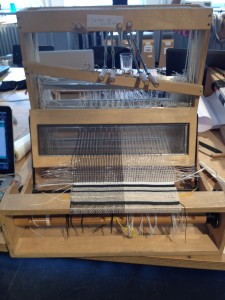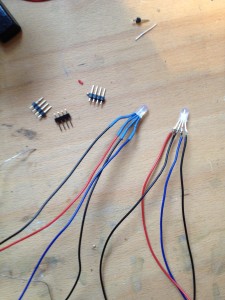For the challenge of creating an interactive light object I decided to experiment with weaving side emitting fiber optics to create an entire fabric that reacted from a sensor.
First using the table top loom, I weaved a 20×20 cm sq of fabric, using the side emitting fiber optics in the weft and cotton in the warp. For displaying the fabric I stretched it in a wooden frame that’s usually used for stretching canvas for paintings.
At first I tried to use a microphone as an input sensor. It worked, but the levels were too jumpy, causing the lights to look like there were constantly flickering.
With Mika’s help I tried to use different techniques of smoothing, but found out if I wanted it to work with a slow fade I would have to use something like this sound detector:
(Sound Detector SEN-12642)
Instead I used a fan to read as an input sensor. Depending how hard you blow into the fan, the LEDs color would change.
For the LED connection I soldered four RGB LEDs to 4, four pronged header pins. I covered each connection with shrink tube.
I connected each LED to a small bunch of fiber optic wire also using shrink tube and electrical tape.
Using Arduino I connected one RGB LED leg to 3 different PWM pins and to GND. From there, I connected each of the other 3 LEDs to the same pins using the bread board. So all 4 LEDs are controlled by the same 4 PWM pins. The fan is connected from an analog pin and GND.
Here’s a video !


